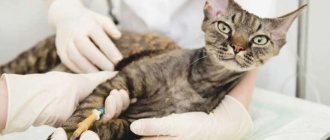Among a number of common types of staphylococcal infections that cause diseases of varying severity in felines, the leading position is occupied by Staphylococcus aureus.
The seriousness of the possible consequences when a cat’s body is affected by this type of opportunistic bacteria, including a high percentage of mortality in sick pets, requires the breeder to have clear knowledge of the main symptoms, nature, and treatment of this dangerous disease.
It is necessary to understand that, having an idea of the picture of this serious disease, the owner not only preserves the health and life of his pet, but also protects people who are in contact with the sick animal from unpleasant consequences.
Features of the microorganism
Staphylococcus is a bacterium. There are several types:
- saprophytic;
- epidermal;
- golden.
The most common is Staphylococcus aureus, which leads to purulent skin lesions. The microorganism can remain in the animal’s body for a long time, but without showing symptoms.
But, under the influence of certain factors, it can become more active. You can see what the disease looks like in the photo of staphylococcus in cats.If such signs are detected, measures should be taken immediately.
Symptoms of the disease
Each cat owner has at least once treated their cats for worms and removed fleas from their furry cat. However, sometimes cats suffer from more serious illnesses. Even indoor cats can contract bacterial infections. The consequences of such diseases can be extremely serious for the health of pets.
One of the dangerous causative agents of infectious diseases is staphylococcus in cats, a microorganism that causes diseases in cats that are difficult not only to cure, but also to the severe complications inherent in these diseases. If we talk about this microorganism more precisely, then under the name “staphylococcus” there is a whole family of pathogenic microbes.
They were discovered more than two centuries ago, having been able to discern their grape-like structure on the primitive microscopes available at that time. This external similarity prompted scientists to name the newly discovered bacterium - in ancient Greek, the word “staphylos” means “bunch of grapes.”
Danger of disease
The study of the effect of staphylococcal infections on the cat's body has led scientists to assume that many of the infectious diseases, especially the etiology of which is unclear, are caused by these dangerous microorganisms. People for whom such a science as microbiology is unfamiliar in detail do not understand what allowed scientists to express such an opinion.
Scientists believed that staphylococci are conditionally pathogenic. They may not show their harmful properties even once during the entire life of the animal in whose body they live. However, when severe stress and other factors occur, staphylococci begin their actions that contribute to the emergence of infectious diseases.
Causes
The main reasons for the development of the disease include:
- excessive amount of carbohydrates in the body;
- weakened immunity. In this situation, Staphylococcus aureus in cats is especially dangerous. With a weakened immune system, purulent lesions appear;
- endocrine system problems caused by hormonal disorders;
- lack of vitamins A, E, B;
- food poisoning;
- allergies, including those associated with the activity of parasites;
- diabetes.
Reasons for the development of the disease
The most common infection in cats is Staphylococcus aureus. As mentioned earlier, this bacterium belongs to the category of opportunistic organisms. This means that it only harms the cat when certain factors act.
At the same time, hemolytic staphylococcus in cats causes purulent formations, which are visible in photographs of sick animals.
The activation of bacteria can lead to:
- a disorder associated with carbohydrate metabolism. This is possible both due to diabetes mellitus and due to improper nutrition of the cat;
- congenital or acquired immunodeficiency;
- disturbed hormonal levels. In most cases, this problem occurs in older cats;
- avitaminosis. A lack of B vitamins, tocopherol and carotene negatively affects the general condition of the body and leads to the activation of bacteria;
- poisoning. Toxic poisoning worsens the cat’s body condition and weakens the immune system;
- allergies, dermatitis, eczema.
The main source of infection is other animals.
The bacterium is excreted from the body along with feces, urine, nasal discharge, pus formed in boils, abscesses, and carbuncles.
In addition, an animal can become infected due to consumption of contaminated milk, food, contact with the fur of a sick cat and household items. Aerogenic infection (through the air) is also possible.
PECULIARITIES ! A cat can become ill after feeding infected kittens (the bacteria can enter the body through areas of the mammary gland damaged by kittens).
Under the conditions described above, staphylococcus begins to harm the body, which causes dysfunction of the cat’s organs and body systems. In addition, the activity of the bacterium leads to the formation of abscesses in tissues and organs.
Can a cat infect a person?
Staphylococcal infections are common in both animals and their owners. Many people are interested in the question of whether it is possible to become infected with staphylococcus from a cat.
There really is such a possibility. The bacterium can enter the body of a healthy person after contact with an infected animal.
Staphylococcus is not a specific infection for only one type of organism. The same type of bacteria can cause disease in cats and people. Therefore, just as a cat can infect a healthy person, a healthy person can infect a cat.
A person can become infected if they come into contact with a sick animal or the substances it secretes.
Staphylococcus can enter the human body after cleaning the tray, contact with a food bowl, or as a result of playing with an animal.
If a cat owner, without washing his hands afterward, eats food or otherwise allows a dirty limb to come into contact with the oral cavity, bacteria will enter the body.
But the chance of infection after a cat bite is much higher. In 2009, a study was conducted regarding human infection with infectious diseases due to animal bites.
THIS IS INTERESTING! According to a report published on its findings, about one percent of all emergency room visits in Europe and the United States are related to animal bites.
Therefore, any bite must be immediately treated with antiseptic agents, and if the first signs appear that not everything is in order with the body, consult a doctor.
Thus, staphylococcus in cats is transmitted to humans both through contact with an infected animal and through bites. You can understand that an animal that has bitten its owner is sick by the symptoms characteristic of Staphylococcus aureus.
IMPORTANT! Even a shallow cat bite is enough to infect a person.
Symptoms of the disease
The ability to timely determine the presence of a disease in a cat’s body is very important both for maintaining its health and for eliminating the possibility of infecting the owner.
Staphylococcus aureus in cats causes symptoms that can be detected even without going to a veterinary clinic.
First of all, the activity of bacteria is displayed on the skin of the animal. The essence of the changes lies in the formation of inflamed areas. They then turn into abscesses.
The constant proliferation of bacteria leads to a rapid increase in their number and the spread of microorganisms throughout the host’s body through his bloodstream.
Due to the accumulation of a large number of parasites in the blood, a substance is released that causes septic shock in the cat.
ATTENTION! Detection of septic shock is a signal to immediately contact a veterinary institution.
Another sign of the presence of bacteria in the body is the spread of ulcers, carbuncles and boils on the animal’s skin. At the initial stage of development of these pathologies, the pet is bothered by itching, so it will scratch intensely at the site of skin deformation.
As the pathology develops, pain occurs, which is why scratches and marks left by the animal’s claws can be seen on the affected areas of the skin.
Staphylococcus aureus in cats also causes the following symptoms:
- general weakness;
- an increase in the animal’s body temperature to forty-one degrees or more;
- increased water consumption;
- loss of appetite.
When the kidneys are damaged, the urine excreted by the animal becomes cloudy. It feels pain when urinating. Feeling the kidneys makes the cat restless.
When the lungs are damaged, a cough occurs and breathing is impaired. Specific symptoms depend on the duration and nature of the disease, as well as on which organs are exposed to bacteria.
You can clearly see what staphylococcus causes symptoms associated with skin lesions in cats in numerous photos of sick animals.
Consequences of the disease
A purulent lesion, which is one of the symptoms of the disease, if left untreated, can develop into weeping dermatitis, which is difficult to treat.
- The longer the disease develops, the wider the areas affected by dermatitis will become. It can even spread to the animal's face.
- The activity of bacteria can cause posthitis in animals - a disease affecting the genital organs of animals.
- The essence of the disease is inflammation of the gap located between the head of the animal’s genital organ and its foreskin.
In purulent discharge, characteristic of the inflammatory process, a large number of staphylococci are found. Animals are difficult to tolerate this disease. It is often accompanied by swelling and severe pain.
IMPORTANT! A characteristic consequence of the activity of Staphylococcus aureus is the development of chronic otitis media and purulent conjunctivitis.
The reason for this is severe diarrhea, which is caused by staphylococcus in kittens under the age of one week. Because of this, rapid dehydration of the body occurs, leading to death due to intoxication.
Deaths also occur among adult cats. One of the reasons is sepsis, described above. If you do not take immediate action when it is detected, there is a high risk of death. Therefore, Staphylococcus aureus found in animals requires immediate treatment.
Treatment
Treatment of an infected animal is prescribed only after diagnosis.
There are many types of staphylococcus, and only testing and microscopic examination of the pathological material of a sick cat will make it possible to make an accurate diagnosis and determine how to treat staphylococcus in examined cats.
If Staphylococcus aureus is found in adult cats, treatment is carried out with antibiotics.
Before prescribing specific drugs, a specialist must check them for the sensitivity of microorganisms found in the body of a sick animal to them.
Internal solutions can be used to relieve intoxication. In addition, a virus that destroys staphylococcal colonies can be used as a therapeutic measure.
Risk of infection for humans
As for whether feline staphylococcus is transmitted to humans, this is quite likely. Infection can occur in the following ways:
- contact;
- airborne;
- nutritional.
Usually a person becomes infected through a bite. A small wound is enough for infection. Even petting a cat or removing its litter box can become infected. Therefore, you should always wash your hands after such actions.
You can't lean close to a cat's nose. You should not contact your face with the cat's face. Children and elderly people are most often infected.
Is staphylococcus transmitted to humans from a sick cat?
Let's try to answer the question that interests many owners - is it possible to become infected with staphylococcus from a cat? Unfortunately, it is indeed possible to become infected, since microorganisms easily penetrate the human body after contact with a sick cat.
Did you know? Staphylococcus can live in a person’s body all his life, but never manifest itself.
Since infection can be transmitted through a bowl or tray, it is very important to wash them thoroughly and also disinfect the room. In addition, you will have to vacuum daily to collect animal hair.
Do not allow your cat to walk around your bed, table, or in places where you spend a lot of time. Ideally, the cat can be isolated during treatment.
After reading our article, you learned what staphylococcus is in cats, how it manifests itself in an animal and methods of treating it. Monitor your pet, examine it regularly and contact your veterinarian promptly if suspicious signs appear.
Was this article helpful?
Yes
No
Signs
The main symptoms of staphylococcus in cats:
- heat;
- apathetic lethargy;
- constant thirst;
- poor appetite;
- general weakness.
It is advisable to undergo treatment at this stage, otherwise weeping dermatitis may develop. Hair falls out on the affected areas.
If the animal is overweight, the disease will be even more severe. At risk are cats with long hair and those suffering from parasites (fleas, ticks).
Next, the hair follicles become inflamed. Bubbles with pus appear. The animal is constantly aggressive and irritated. Sleep is disturbed, the cat refuses to eat.
If you don't take action, boils will appear. The genitals, auditory organs and eyes are also susceptible to pathogenic effects.
Lesions of the genital area
An extremely specific sign of staphylococcal infection is generalized damage to the mucous membranes of the genital organs. In cats, this manifests itself in the form of purulent vaginitis. If there is no treatment, the process is complicated by endometritis. At the same time, cats suffer from severe fasting. Their presence can be detected by a large amount of pus discharged from the preputial sac. Microscopic examination of such exudate reveals a huge number of staphylococci belonging to various strains.
Persistent otitis media is another specific symptom. In mild cases (in adult animals), ear inflammation does not appear visually; the cat can only occasionally shake its head and scratch the ear area. In more severe cases, it is enough to massage the ear to feel the large volume of exudate accumulated there. If the lesion is severe, the process involves the auricle, which becomes severely inflamed and ulcerated. All affected areas are red and swollen. When palpating or even stroking, severe pain appears. In fairly rare cases, staphylococcal infection also leads to the development of serous or purulent conjunctivitis.
Diagnostics
Before treating staphylococcus in a cat, it is recommended to conduct a diagnosis. To do this, you should contact your veterinarian. To diagnose the disease, a blood test is performed, skin scrapings are done, and smears are taken from the genitals.
Seizures in cats - main causes, symptoms, first aid, treatment and choice of drugs (110 photos)Polycystic kidney disease in cats - causes, diagnosis and symptoms of the disease. Treatment options and prevention of kidney disease (95 photos)
Tartar in cats - signs of the disease and methods of fully treating tartar (125 photos + video)
It is not a general blood test that is performed, but a bacterial culture test. Standard analysis will not give an accurate result, since pathogenic changes can only be seen at the stage of sepsis.
Treatment
Self-treatment will not lead to anything good in this situation, therefore, if you suspect the presence of this pathology, you urgently need to contact a veterinarian, tell him that you have concerns that the cat is developing staphylococcus, and ask to prescribe treatment.
If the cat has other abnormalities, for example, problems with the liver and stomach, if the animal is too young or old, treatment is selected taking into account all individual characteristics, which is what the veterinarian will do.
The veterinarian will immediately prescribe a strong antibiotic with a wide spectrum of action for a sick cat. It must be given to the cat for at least three weeks. But if the course comes to an end, and the disease does not leave the animal, it is better to change the drug and treat the animal again. You shouldn't do this yourself. It is better to do a culture in the laboratory and determine the substances to which pathogenic bacteria have resistance. After this, the doctor will be able to prescribe a remedy that is more effective and less dangerous for the cat.
Usually, cats suffer from other ailments in parallel with a serious illness, so complex treatment is prescribed. It is aimed at fighting the disease, supporting the body, and boosting immunity. Vitamin complexes, drugs that strengthen the immune system, and drugs that support the digestive system are prescribed when taking antibiotics.
In especially severe cases, they resort to using a dropper. Through it, the necessary salts and minerals can be introduced to ensure the normal functioning of the substance if the cat is not able to eat food on his own.
For severe lesions of the skin, special healing and antibacterial agents and ointments for dermatitis are used.
Preventive measures
Feline staphylococcus is difficult to treat, so it is better to prevent the disease in advance. All measures should be taken to avoid the disease.
Care must be taken to ensure that the cat does not come into contact with stray animals. It is necessary to monitor the completeness of the pet’s diet.
Excessive consumption of potato foods, cereals and flour products is fraught with the formation of excess carbohydrates.
Improper nutrition leads to a lack of vitamins in the animal’s body, as a result of which the immune system deteriorates and bacteria begin to act actively.
If your cat has chronic diseases, you should not let them go. It is extremely important to carry out regular pest control.
Ringworm in cats - main signs, symptoms, prevention and treatment of ringworm in cats (105 photos)Pancreatitis in cats: first symptoms, nutritional nuances and treatment options (125 photos and videos)
Subcutaneous mites in cats - first symptoms, treatment options and real photos of examples of parasite damage (110 photos + video)
Fleas and ticks are one of the common causes of staphylococcal bacteria. Therefore, veterinary remedies should be used against cat parasites living in fur.
Preventive actions
In order to protect your pet from infection with staphylococcus, we recommend using the following tips:
- warn the cat from damaging the skin;
- after walking the animal, you need to thoroughly wash the fur and wash it;
- limit your cat’s contact with stray animals, do not let them go for walks in places where staphylococcus may be present;
- Avoid the appearance of ticks and fleas on your cat - use special preparations.
By taking preventive measures, you significantly reduce the risk of contracting a dangerous disease to your pet.
Photo of staphylococcus in cats
Read here Eye diseases in cats: symptoms of diseases and their main causes. Main treatment options and prevention of the disease (115 photos)
Help the site, share with friends 
Symptoms
Staphylococcus manifests itself in a cat with symptoms typical of many other diseases, such as increased body temperature, decreased appetite, and lethargy of the cat. In addition to these signs, there are more significant ones. A cat may be sick with Staphylococcus aureus if:
- the entire surface of the dermis was covered with festering ulcers;
- the cat is rapidly going bald;
- the animal suffers from diseases of the genital area;
- The cat was diagnosed with otitis media or conjunctivitis.
If a cat suffers from dermatitis, you should urgently consult a doctor, because it can soon develop into pyoderma (purulent inflammation), which is difficult to treat.
With baldness, wounds with purulent exudate are found on the skin - the cat is sick with staphylococcus. In this situation, irreversible processes begin that affect the subcutaneous tissue. Boils develop under the dermis, which is accompanied by elevated temperature and a high content of leukocytes. This is a severe form of the disease and requires immediate treatment.
If a cat develops endometritis, this may well indicate that along with it there are staphylococcal bacteria in the body that need to be gotten rid of. Feline vaginitis can also herald the development of the disease.
Inflammation of the ears and eyes during infection with staphylococcus can be very severe. As for kitten diseases complicated by staphylococcal infection, they are much more difficult to tolerate and almost always lead to death.
How is the treatment carried out?
Antibacterial drugs are the basis of treatment for this infection.
Feline staphylococcus has several types, so in the process of diagnostic measures it is important to determine the type of pathogenic microorganism. This manipulation is required to prescribe the most effective medications. First of all, they resort to the help of antibacterial drugs. Intravenous administration of solutions will help to cope with poisoning of the body and improve the general health of the cat. In addition, immunomodulators are also prescribed for pets, which improve the functioning of the immune system. Therapy is not complete without vitamin-mineral complexes, which help to establish the body’s defenses.
Since staphylococcus affects the skin, animals are prescribed medications for external use that contain sulfonamide. If the disease is severe, they resort to the help of droppers, which support the pet’s condition. They are prescribed in situations where the animal cannot eat food on its own.
“Bacteriophage” is often used in the treatment of staphylococcus. It is a molecular nanomechanism that penetrates the bacterial membrane and fills it with genetic material, achieving complete breakdown of the microorganism's membrane. This solution will need to be applied to the affected areas as a lotion.
If the animal owner fully follows all the doctor’s recommendations, the animal can be cured in 1 month.











